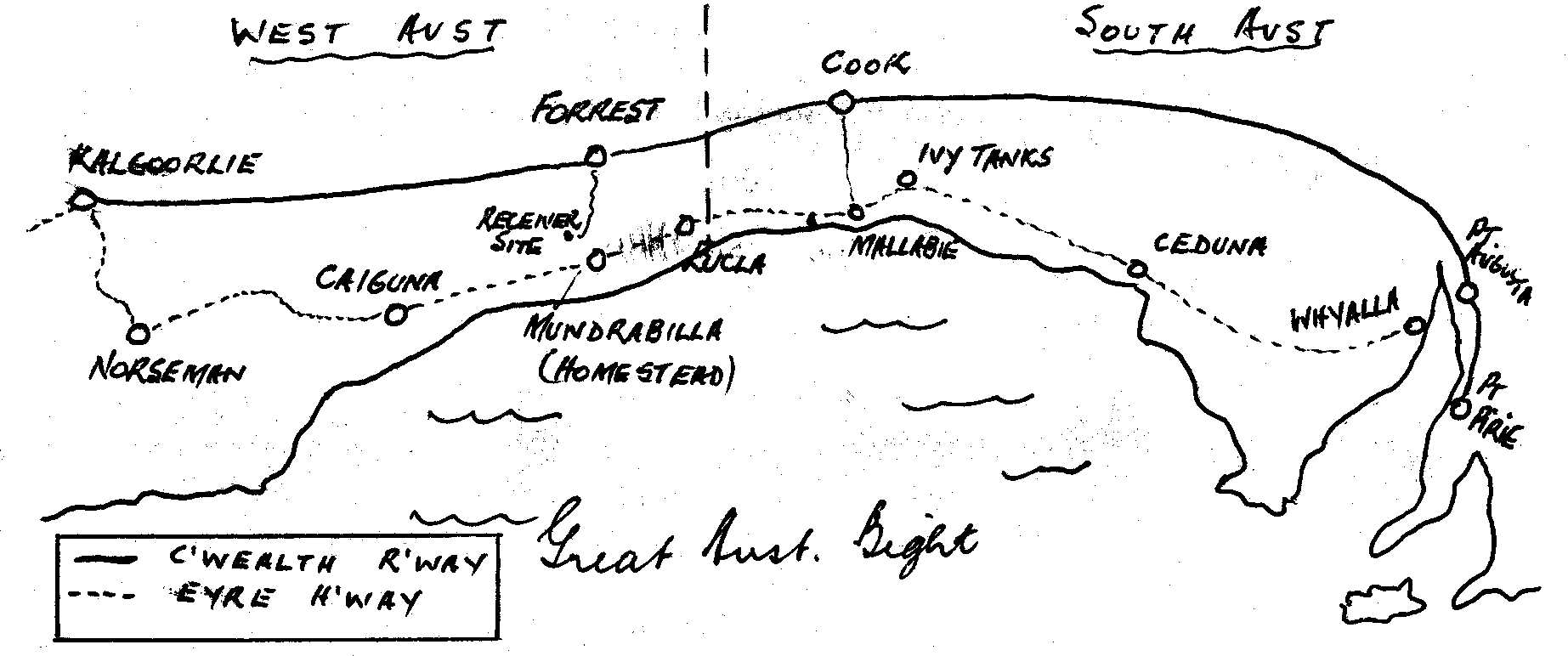
MICROWAVE PROPAGATION MEASUREMENTS ON THE EAST-WEST ROUTE
(With thanks to Jim Lucas and Barry Thomas)
The East-West or Nullarbor Project- what was it all about? Now that it is all over perhaps it is too late to say anything or, perhaps, it is better late than never. Certainly, it would take a large volume to record all of the sidelights of peoples' lives whilst on the Project.
First, the reason why - To measure, over twelve months, the average signal levels, noting all special changes such as "fading" and "depressions" coupled with observation of meteorological conditions which could have an effect on signal level changes.
There were three main sites, namely Mundrabilla, Ivy Tanks and Head-of-Bight.
Mundrabilla had two adjacent transmitter sites, one on top of the inland escarpment and one a few miles south and below the escarpment on the coastal plain. These two sites looked westward to the receiver site, which was perched on the top edge of the inland escarpment (The escarpment rises 250 feet above the coastal plain).
Ivy Tanks consisted of a Centre site (receivers) plus an East and a West transmitter site approximately twenty-five miles either side of the Centre site.
The Head of Bight receivers were located at Mallabie with the 1 transmitter site, Wigunda, twenty seven road miles further west.

Staff (usually a T.O.1 and a technician) were provided on a continuous basis to carry out the necessary tests. Their daily routine (most times seven days a week) involved the running of the station and the maintenance of:
Since the transmitters were usually 30 to 35 road miles away a good deal of travelling was involved over roads that could barely be called tracks. Rain could be a problem due to the nature of the Nullarbor soil. A few points of rain could turn the Plain into a great bowl of soft brown custard.
Two Landrovers were rolled over without anyone really trying, while the great open Eyre Highway after recent heavy rains became, to quote from a log entry.."a brown, liquid hell". Long walks were not unknown when vehicles became hopelessly bogged.
For the men to maintain themselves it was necessary to be a cook/bottle washer and general rouseabout. Most blokes had their specialities - bread, a baked rabbit or spaghetti bolognaise and after awhile all became, if they weren't at first, quite reasonable cooks. A visiting working party arrived at one site to find the home team busy making apple pie for dessert, so it wasn't just baked beans for every meal. We won't elaborate on the tale of a man known to all as "Foxy" or of the fellow known far and wide for his love of raw meat.
A typical trip went something like this; depart Melbourne by plane to Adelaide on a Wednesday morning, thence train to Port Pirie and board the Commonwealth Railways Transcontinental Express arriving at Cook about seven o'clock Thursday morning. The team for Ivy Tanks or Head-of-Bight would alight whilst those for Mundrabilla would remain aboard for breakfast and go on to Forrest, W.A., a further 240 miles.
At Cook or Forrest the procedure was much the same, to doff good clothes, don the old "desert clothes," pick up the vehicle (a 4 wheel drive Landrover or Toyota) load and set off on the track to the Eyre Highway, some 80 to 100 miles south. The feeling of utter loneliness at being "dumped" and seeing the train slowly disappearing into the distance, while around is only a handful of houses, was one that will be hard to forget.
On arrival at the site there was the usual unpacking and storage of provisions, the inspection of charts and equipment and, finally, settling in for a two week stay.
After a fortnight came the same loading, packing and the long journey back to Melbourne with two weeks supply of propagation, meteorological and other charts and records.
Either at Forrest or Cook going to, or coming from the field we found the same superb hospitality and company of the P.M.G. Repeater Staff awaiting us. Many a communal evening was enjoyed with good food and an ample supply of liquid refreshment. The opportunity should not be allowed to pass to name these good people as their efforts, technically as well as socially, often went above and beyond the call of duty. At Cook, the past Supervising Technician BARRY MINKWITZ and his wife JOAN, the present Super. Tech. MICK COLLINSON and his wife ROSE MARY (who is at this moment in the Cook Hospital suffering from hepatitis - Good wishes go to Rosemary from all her friends at the Labs for a speedy and complete recovery from this serious illness), MALCOLM CROSSE and wife KAY and BRIAN and PAM SARD. They will all be remembered for their excellent hosting. AT Forrest, last but by no means least KEN TAYLOR and his wife ANN were almost worn out making cups of tea and coffee and opening countless cans of good cheer for weary and thirsty Research bods.
The project occupied almost eighteen months of intensive toil and provided a never to be forgotten experience for all those associated with it.
Reprinted from the Research Lab Reporter December, 1968